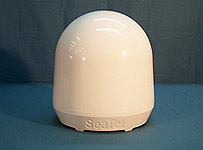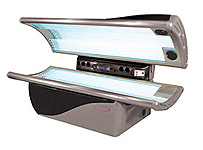Thermoforming Case Studies
Radome Assembly
 Golden Plastics Corp. had been supplying vacuum formed plastic Radome Assemblies to our customer for years. The Radome Assemblies consisted of a Base and Dome which enclose a satellite communication system for offshore ship communications. Our customer was developing a new system that would require a new Radome Assembly. Golden Plastics Corp. had been supplying vacuum formed plastic Radome Assemblies to our customer for years. The Radome Assemblies consisted of a Base and Dome which enclose a satellite communication system for offshore ship communications. Our customer was developing a new system that would require a new Radome Assembly.
The design goals were:
1) To form the customer's name into the side wall of the Base
2) To minimize the amount of secondary parts
3) To increase the overall strength of the assembly
Working with our customer, we used Solid Works solid modeling program to create and finalize the design.
Pressure Forming Process
The pressure forming process was selected to produce the Base of the assembly. This process enabled the customer's name to be formed into the side of the Base and also allowed for a large undercut step around the entire top edge. The .375" thick Base was formed on a MAAC three-station rotary pressure forming machine. Due to the thickness of the material being formed, the ability to precisely control the oven zones for a uniform sheet temperature was critical to this application. The use of locking platens was also required, due to the high pressure needed to successfully pressure form the undercut area.
The Dome part of the assembly utilized the snap-back vacuum forming process. By snap-back forming the Dome, a uniform wall thickness was achieved. The Dome also has a vacuum formed Internal Mounting Ring that is bonded in for extra rigidity.
Tooling
The tooling for this project included both in-house and out-sourced tooling. Portage Casting and Mold provided the temperature controlled cast aluminum pressure forming mold for the Base. Portage engineered the undercut ring design by constructing four pneumatically retractable ring sections. The Dome and Internal Dome Ring molds were built by Golden Plastics as high temperature aluminum filled epoxy molds.
Materials Selection
The material for this project had to be able to withstand extreme weather conditions and the rigors of a service life at sea. A co-extruded sheet consisting of an ABS substrate with an Acrylic Cap sheet was selected. The ABS provided excellent structural strength characteristics while the Acrylic Cap provided excellent UV protection. The high gloss finish of the Acrylic Cap also eliminated the need to paint the parts.
All of the Radome Assembly parts were trimmed on Motion Master 5-Axis CNC routers. Automated part trimming ensured repeatable results and consistent part quality.
Cost Savings and Durability
Cost savings and durability are the primary benefits of this assembly. Cost saving over the previous all vacuum formed design was accomplished by the elimination of secondary parts and assembly labor. The monolithic pressure formed Base cut labor costs and also produced a very durable finished assembly.
Tanning Bed Enclosure
 Golden Plastics had been supplying vacuum-formed plastic parts to our customer, a tanning bed manufacturer, for many years. Our customer decided to update the look of their tanning bed and asked Golden Plastics to redesign the exterior panels of the bed and to explore different material options. The challenge was to create a new sleek design that would fit the existing frame and to add new color options to the existing black and white colors. The tooling costs also needed to be kept low due to the number of parts required for the assembly. Golden Plastics had been supplying vacuum-formed plastic parts to our customer, a tanning bed manufacturer, for many years. Our customer decided to update the look of their tanning bed and asked Golden Plastics to redesign the exterior panels of the bed and to explore different material options. The challenge was to create a new sleek design that would fit the existing frame and to add new color options to the existing black and white colors. The tooling costs also needed to be kept low due to the number of parts required for the assembly.
Project Design
The tanning bed manufacturer supplied Golden Plastics with the frame of the bed and some pencil sketches for design concepts. No drawings existed for the frame so we used our Faro Arm to reverse-engineered the frame and created a solid model. We used Solid Works solid modeling program to design the exterior panels and to ensure that the entire assembly fit together properly. The use of solid modeling allowed our customer to view a 3-Dimensional drawing of the proposed assembly and to make design changes before any molds were made.
In-House Forming Molds The forming molds were also designed in Solid Works then translated into SURFCAM to generate the tool paths for machining the mold masters. The masters were CNC machined in house on our 3-Axis Motion Master Router. Using the machined masters the production molds were produced from high temperature aluminum filled epoxy. By producing the molds in house, the tooling costs were kept to a minimum.
Once the parts were formed, a set of parts were hand trimmed to fit the frame and one another. These hand trimmed parts were used as templates to produce the trim paths for routing. The Faro Arm was used to input the hand trimmed part dimensions directly into SURFCAM, where the paths were graphically edited and posted out as CNC code. Trim fixtures were produced to hold the parts for the trimming process on our 5-Axis Motion Master CNC Routers.
Materials Selection The selected material had to have a bright cosmetically pleasing look that was resistant to the ultra violet rays generated from the tanning bed lights. After looking at various different materials, a tri-extruded sheet was selected. This material consisted of an ABS substrate with a colored Acrylic mid layer and a final clear Acrylic Cap sheet. The ABS provided the structural strength, the middle Acrylic layer provided the color and the clear Acrylic Cap sheet provided a high gloss depth to the finish parts. The ultra violet resistant properties of the Acrylic also provided the parts with excellent color retention, even after years of service.
The final result is a sleek and stylish tanning bed. The thermoforming process and material selection eliminated the need to paint the part without sacrificing cosmetic quality. The vacuum forming process also allowed for the use of comparatively inexpensive tooling. Since the completion of this tanning bed project, Golden Plastics has designed and produced the thermoformed exteriors for 3 more tanning beds. |